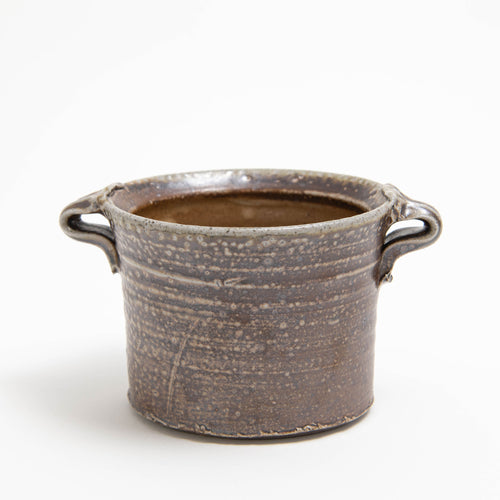At the gallery we think one of the most interesting aspects of a potter's life - or indeed the life of any kind of artist - is their place of work. How does the local landscape shape and influence a maker's processes, their aesthetic, even their philosophy?
For many of our gallery potters, a sense of place, of working in a special and specific geography with its own history of past working traditions, is all-important. So we thought we'd offer you a photographic tour of their studio workshops and the surrounding landscape that informs so much of what they do.
To start us off, the ethereal sea and snow of Bornholm, home to Danish potter Anne Mette Hjortshøj.

Anne Mette's studio is housed in an old 19th century farmhouse, complete with ramshackle barns and sheds, on the West coast of Bornholm, a small Danish island in the Baltic Sea just off the southern tip of Sweden. Fewer than 40,000 people now live on the island, with as little as 14,000 living in its largest town Rønne, a few miles from Anne Mette's workshop.
Despite its small population, Bornholm has a long history of local craftsmen and women and has been a home to potters since the 17th century. Anne Mette trained at the Bornholm School of Glass and Ceramics in one of the first groups of students to be admitted to the school soon after it was established.


Since setting up her own studios, Anne Mette has built three kilns, the most recent being a two-chambered wood-firing kiln constructed back in September 2011, sheltered within the outbuildings of her farmhouse studio.
Firings take place with the help of a Swedish ceramic artist and often involve salt-firing, a method that produces the characteristic 'orange peel' salt-glaze texture evident on many of Anne Mette's pots.


While the exterior of Anne Mette's farmhouse is typical of the crumbling red-brick agricultural and industrial buildings of the late 1800s, inside the studio is modern and quintessentially Scandinavian, reflecting the balance in Anne Mette's ceramics between honouring the long-lasting tradition of functional pottery on Bornholm, and more generally Denmark, and working with a contemporary and personal touch.
Littered amongst her own pots, scattered about windowsills and rudimentary shelving units, are bowls of slip, improvised decorative tools, and Anne Mette's own handmade clay stamps which often feature on her large teapots.






Many of the pots Anne Mette makes are distinctly functional - teapots, jugs, dishes and bowls - and sit as comfortably on her shelves, bay windows and table tops as more contemplative pieces made for display. Like their maker, they are quiet, humble, sincere and unpretentious, but with great warmth and generosity.


In the northern light of Bornholm, with a white wood background or set on a bright, flaked-paint cabinet, the variation in their colours and surfaces comes to the fore. As Anne Mette describes, the surrounding landscape of snow, farmlands, pine forests and ragged coastlines is naturally reflected in her work. She does not set out to describe her local environment on her pots; but an instinctive sympathy with the natural world sees these elements appear on the surfaces of bottles and vases, or in the dappled pits of salt-glaze clay:
I don't think about it, when I make work, that I am inspired by nature - I don't think about it literally. But of course I am. Sometimes I do look out the window or am standing looking at a beautiful tree; sometimes it's the reverse, when a piece comes from the firing and it’s exactly the same colours as when it’s winter and just about to be sunset. There’s white, thick snow with a little bit of moss coming up, and you have the blue sky, then you have this pinkish orange starting on the horizon…it’s nature, so the two just meet in funny ways.



Much of Bornholm's ceramic history is owed to the island's natural geological makeup. Large sedimentary layers of clay run along the coastal cliffs, many of them containing natural minerals and oxides deposited by veins of running water.
Generations of potters have sourced their clay from these cliffs and the underlying beaches, including the famed Danish potters Gutte Eriksen and Gertrud Vasegaard, the latter a Bornholm local who worked on the island itself.


Anne Mette also gathers clay from the Bornholm coastline for use in her slips and glazes, rather than as a clay body for throwing and forming pots, its naturally occurring iron oxide allowing for a variety of rich red tones in the glaze surface.
Though the red and green clay layers appear starkly different, they are in fact the same. Where water has run through the lower layers it has oxidised the clay and, as when iron rusts, lent it its deep red-brown colour.


It is not difficult to see how a place like Bornholm can cast its magic on its creative inhabitants. Like the studio workshop of Anne Mette Hjortshøj, life on this island seems calm and slow, unfettered by the constant business of big cities.
The warm glow of sunlight on cold blue snow tells us that this is a reflective place, one of quiet contemplation and of great natural beauty, qualities that Anne Mette's work innately possesses and which their maker personifies.











